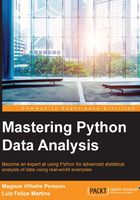
Preface
The use of Python for data analysis and visualization has only increased in popularity in the last few years. One reason for this is the availability and continued development of a number of excellent tools for conducting advanced data analysis and visualization. Another reason is the possibility of rapid and easy development, deployment, and sharing of code. For these reasons, Python has become one of the most widely used programming and scripting language for data analysis in many industries.
The aim of this book is to develop skills to effectively approach almost any data analysis problem, and extract all of the available information. This is done by introducing a range of varying techniques and methods such as uni- and multi-variate linear regression, cluster finding, Bayesian analysis, machine learning, and time series analysis. Exploratory data analysis is a key aspect to get a sense of what can be done and to maximize the insights that are gained from the data. Additionally, emphasis is put on presentation-ready figures that are clear and easy to interpret.
Knowing how to explore data and present results and conclusions from data analysis in a meaningful way is an important skill. While the theory behind statistical analysis is important to know, to be able to quickly and accurately perform hands-on sorting, reduction, analysis, and subsequently present the insights gained, is a make or break for today's quickly evolving business and academic sector.